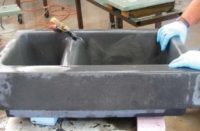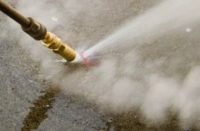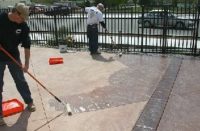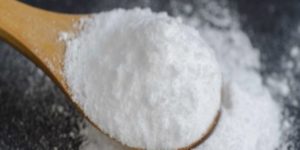
Question: I was wondering if you could help me understand why I’m getting uneven gloss on this stamped concrete patio I just completed for a customer. The concrete cured for 45 days before sealing. The surface was clean and dry. The sealer was roller applied midafternoon to evening, and I used 5 gallons for approximately 600 square feet. The picture shows what the patio looks like about one week after sealing.
Right after the sealer was applied, the entire slab looked like the dark spots with the “wet look,” which is what we wanted. As time passed, the wet look began disappearing, turning to the lighter gray, which we didn’t want.
What can I do to help make the gloss and dark color uniform across the slab, and have it stay that way?
Answer: This issue of blotchy and inconsistent color and gloss created by a sealer is not that uncommon. There are multiple factors that can create this appearance, but the two most common are application — how the sealer was applied — and surface — what the sealer is being applied to in regard to density and porosity.
The application side can be controlled. You have to deal with the surface side.
Application or absorption?
When applying a sealer, consistent application, using the recommended application method and targeting the recommended coverage rate are critical to achieving the desired protection, color and gloss. The picture shows random dark gray areas that are clearly defined compared to the lighter gray color that makes up most of the patio.
The blotchy dark areas can also be described as having a higher gloss and more of the “wet look” compared to the surrounding lighter-colored concrete. The dark areas have the distinct pattern achieved when roller applying a sealer that results in inconsistent coverage.
From the evidence provided, one can conclude that the sealer is forming a thicker film in those areas that are darker. The question then becomes: Was the sealer improperly applied or did the concrete inconsistently absorb the sealer?

Consider the coverage rate
We know from the provided information that the patio is about 600 square feet, and an entire 5-gallon pail of sealer was used. Based on the universal sealer coverage rate of 300 square feet per gallon, the first coat should have consumed a little bit more than 2 gallons of sealer. A second coat should consume the same or possibly slightly less. Factoring 10 percent for loss and waste, and using a perfect world scenario, there should have been about a half gallon of sealer remaining.
Since we don’t live in a perfect world, and applying sealer with a roller on stamped and textured concrete usually yields lower coverage rates, I can see where a full pail could easily have been used. So does this automatically conclude that the issue was caused by the concrete and not the application? Not necessarily! What we don’t know is the sealer type and the solids content, which can play a part in gloss, life span and absorption.
Contributing factors
Considering what we know and what the pictures show us, we can conclude a few factors are involved in creating the blotchy dark areas. This is not a surprise, since very few issues in our industry are created by a single source.
I think the biggest culprit is the application method. As the saying goes, the evidence doesn’t lie, and the photo evidence is pretty clear. There is no denying that a saturated roller created the blotchy dark spots. The shine and depth of color in the dark areas indicate significantly more sealer than the lighter areas. The long, narrow, rectangular shapes of the dark spots further support the claim of a heavy hand with a roller.
It appears that in certain areas the roller was run across the surface loaded with sealer in short, narrow patches leaving a higher concentration. The roller was worked across most of the patio surface spreading the sealer out thinner and more consistent.
Not to lay all the blame at the feet of the installer, I also think that the concrete looks like it absorbed the sealer differently. This is a secondary factor leading to the significant dark spots. If the concrete was finished and/or stamped inconsistently, this could lead to the sealer absorbing at different rates increasing the inconsistencies.
To a lesser degree, but still important to note, are low areas in the concrete where sealer can puddle and increase the inconsistencies. The type of sealer, in regards to solids content and resin quality, also impacts the final look. You typically get what you pay for when it comes to sealers. A cheap sealer with low solids can dull out quickly, especially in areas with high sun exposure.
Answering the question
The final question was: How do I fix the issue so the patio would be dark and shiny moving forward? The short answer is: Apply more sealer!
A word of caution: Sealers are designed to provide a level of protection and gloss at a recommended thickness. Expecting a sealer to do something it’s not designed for is a recipe for disaster. So, my suggestion would be to seal the surface — spraying, if at all possible, in thin coats until a uniform color and gloss is achieved.
Keep in mind that the sealer being used may not be designed to provide a high gloss or a wet look on exterior surfaces. Before proceeding, you should research the sealer and determine if another product may be a better fit. If a sealer change is made, a test area needs to be applied to assure compatibility and that the desired results are achieved.















